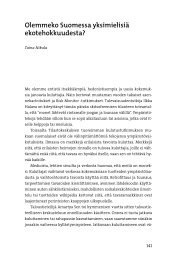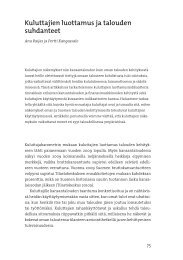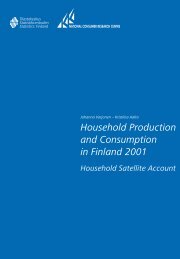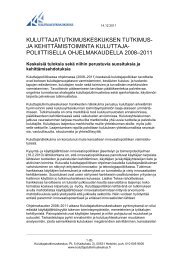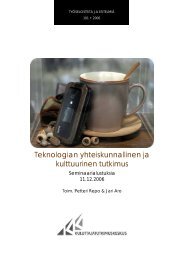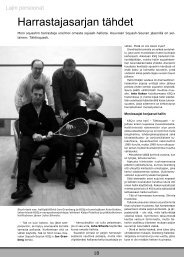Household Production and Consumption in Finland 2001
Household Production and Consumption in Finland 2001
Household Production and Consumption in Finland 2001
You also want an ePaper? Increase the reach of your titles
YUMPU automatically turns print PDFs into web optimized ePapers that Google loves.
<strong>Production</strong> for own use accounts for 88 per cent of extended household<br />
sector output. The share of volunteer work is 6.5 per cent. <strong>Production</strong> for own<br />
use accounts for an ever greater share of gross value added, i.e. 91 per cent,<br />
with volunteer work represent<strong>in</strong>g 8 per cent of this.<br />
<strong>Household</strong> disposable <strong>in</strong>come <strong>in</strong>creases by some 80 per cent by virtue of<br />
household production, i.e. from 64 billion to 116 billion euros. This, however,<br />
is an imputed <strong>in</strong>crease; households do not actually get to see this money. It<br />
may be described as a “compensation” that materialises <strong>in</strong> the consumption of<br />
the goods <strong>and</strong> services that households have produced for themselves. On the<br />
other h<strong>and</strong>, if households wanted to ma<strong>in</strong>ta<strong>in</strong> the same level of consumption<br />
without own production, they would have to buy the correspond<strong>in</strong>g products<br />
<strong>in</strong> the market <strong>and</strong> the money they spent on these goods <strong>and</strong> services means<br />
that they would have less to spend on someth<strong>in</strong>g else. So although the <strong>in</strong>crease<br />
<strong>in</strong> disposable <strong>in</strong>come is only imputed, its impacts are very real. Volunteer work<br />
accounts for 5 billion euros of this imputed <strong>in</strong>come. It is not the household<br />
that has produced this work that reaps the benefits, but at a national level the<br />
beneficiaries are nonetheless private households.<br />
Extended household consumption<br />
<strong>Household</strong> consumption is also <strong>in</strong>creased. It is a key characteristic of services<br />
that their production <strong>and</strong> consumption are closely <strong>in</strong>tertw<strong>in</strong>ed with each other<br />
(SNA 1993, 6.8). It follows logically that households also consume the services<br />
that they produce for their own use (with the exception of neighbourly help<br />
<strong>and</strong> other volunteer work, which is consumed <strong>in</strong> some other household).<br />
Extended household consumption consists of the consumption of the f<strong>in</strong>al<br />
products purchased by households <strong>and</strong> of the consumption of products that<br />
households have produced for themselves. Here we need to take <strong>in</strong>to account<br />
the items already <strong>in</strong>cluded <strong>in</strong> the core national accounts under consumption,<br />
i.e. the <strong>in</strong>gredients, raw materials <strong>and</strong> other <strong>in</strong>termediate consumption goods<br />
<strong>and</strong> services, as well as capital goods purchased by households <strong>in</strong> <strong>2001</strong>. These<br />
items must be subtracted from consumption to avoid duplicate count<strong>in</strong>g. In<br />
addition to household consumption, the figures <strong>in</strong>clude the consumption<br />
expenditure of general government, the biggest items of which are health<br />
expenditure <strong>and</strong> education. Non-profit <strong>in</strong>stitutions serv<strong>in</strong>g households <strong>in</strong>clude<br />
religious associations, sports clubs, etc. The <strong>in</strong>dividual consumption<br />
expenditure of general government <strong>and</strong> non-profit <strong>in</strong>stitutions is f<strong>in</strong>anced<br />
through social <strong>in</strong>come transfers. Add<strong>in</strong>g them to household consumption<br />
expenditure results <strong>in</strong> <strong>in</strong>dividual consumption expenditure. The figures are as<br />
follows (exclud<strong>in</strong>g collective consumption):<br />
64 Statistics F<strong>in</strong>l<strong>and</strong> National Consumer Research Centre




